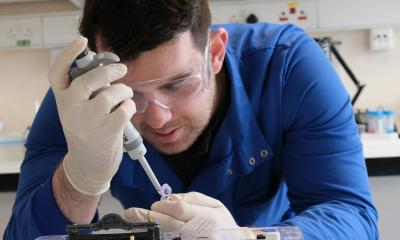News • TB test shows promise
New method to assist fast-tracking of vaccines
With Covid-19 dominating medical science and human concern, chemists at the University of Sydney have developed a method to quickly and safely synthesise protein vaccines for respiratory diseases for pre-clinical tests.
Their approach can be used to test vaccine strategies against novel pandemic pathogens such as SARS-CoV-2, the virus that causes Covid-19. Their results are published in the Proceedings of the National Academy of Sciences of the United States of America (PNAS).

Led by Professor Richard Payne at the University of Sydney and Professor Warwick Britton at the Centenary Institute, the team has demonstrated application of the method with a new vaccine for use against tuberculosis (TB), which has generated a powerful protective immune response in mice. Researchers are keen to develop the vaccine strategy further to assist in the rapid pre-clinical testing of new vaccines, particularly for respiratory illnesses. “Tuberculosis infects 10 million and kills more than 1.4 million people every year,” said joint first author Dr Anneliese Ashhurst from the University of Sydney. “Historically, it is the leading cause of death worldwide from a single infectious agent. So far, a TB vaccine that is highly effective and safe to use in all populations has eluded medical science.”
The only current vaccine for tuberculosis, the Bacille Calmette-Guerin vaccine, uses an injected live bacterium. It is effective in infants but has reduced effectiveness in adolescents and adults and poses significant health risks for immunocompromised patients, particularly for people living with HIV/AIDS. Protein-based vaccines have been shown to be very safe, but they must be mixed with enhancers, or adjuvants, to make them effective, which is not straightforward. Dr Ashhurst said: “The challenge is to ensure that our immune cells see both the protein and adjuvant simultaneously. To overcome this difficulty, for the first time we have developed a method that synthesises the protein with an attached adjuvant as a single molecule.”
The vaccine strategy and synthetic technology could be deployed to rapidly generate new vaccines for pre-clinical testing for a range of diseases, the researchers say, including the respiratory pathogen that causes Covid-19.
Image source: CDC/ Antibiotic Resistance Coordination and Strategy Unit / Medical Illustrators: Alissa Eckert; James Archer
In order for vaccines to be effective, they need to stimulate behaviour in protective T-cells that allows them to recognise the pathogen as an antigen, or foreign body. In the case of tuberculosis, our immune system needs to respond quickly to the bacteria that causes TB – Mycobacterium tuberculosis – to reduce infection in lungs.
Using the method developed by the Sydney scientists, an inhaled vaccine provides a low-dose immune-stimulating molecule – containing a synthesised bacterial protein attached directly to an adjuvant – to the immune cells in the lungs.

A major hurdle overcome by the scientists was the difficulty in fusing hydrophobic (water-repellent) adjuvants with a water-soluble protein antigen. “We got around this problem of keeping hydrophobic and hydrophilic molecules together in a vaccine by developing a way to permanently bind the protein and adjuvant together as a single molecule using synthetic chemistry. Our approach overcomes the solubility problems faced by other methods,” said Professor Payne from the School of Chemistry and Deputy Director of the ARC Centre for Innovations in Peptide & Protein Science (CIPPS).
The team says that synthesising an entire bacterial protein with attached adjuvant has not been achieved before. Professor Britton from the Tuberculosis Research Program at the Centenary Institute said: “As well as providing a rapid method to develop a range of vaccines for pre-clinical testing, we expect that this pulmonary vaccination approach will be particularly beneficial for protecting against respiratory diseases.” He said: “We hope that an inhaled vaccine for tuberculosis using a protein-based immunisation will allow us to develop a universal and safe approach to combatting this deadly disease.”
The other major advantage with this method is that vaccines for a range of diseases can be developed rapidly and safely in the laboratory. “We don’t need to grow the actual pathogen in the lab to make the vaccine,” said Dr Ashhurst, who holds a joint position in the School of Chemistry and the School of Medical Sciences. “Using this new method, we can rapidly and safely synthesise highly pure vaccines in the lab and take them straight into animal models for pre-clinical testing.”
Source: University of Sydney
20.01.2021











